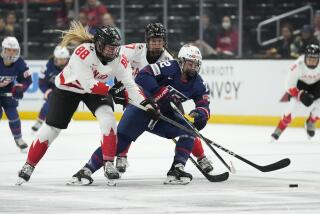‘You have to dedicate yourself if you want to do something. You have to work at it.’
- Share via
Willie O’Ree, the first black player in the National Hockey League, played 20 years of professional hockey, including seven with the San Diego Gulls, before retiring in 1980. O’Ree, 54, a La Mesa resident, is now an executive with a company providing security for the Chargers at San Diego Jack Murphy Stadium. O’Ree was interviewed by Times staff writer G. Jeanette Avent and was photograped by Bruce K. Huff.
I started skating when I was about 3 years old and started playing organized hockey when I was 5. I used to skate down the street and skate to school. I was constantly on the ice. I was fortunate to be born and raised in cold country. Fredericton in New Brunswick, Canada, where I grew up, borders the state of Maine. In the wintertime, my dad just turned a hose on out in the back yard and, boom, instant rink.
The thing that really got me obsessed about hockey was just the speed that I could obtain on a pair of skates, the things you could do with a stick and a puck traveling across the ice. They said I was one of the fastest skaters in professional hockey. I played with guys who were just as fast as me, but the one thing that was a big asset for me was I could be standing still, take about four strides and be at top speed, while other guys may take seven or eight to get going.
I had strong legs and strong ankles, and I really didn’t have any problems with injuries to my legs or knees. Usually players get torn ligaments in their knees, and it ends their career. But I was very fortunate. I played 20 years. Usually a hockey player plays 10 or 12 years.
The worst injury I ever had was an eye injury. I was struck in the right eye with a puck in 1954 when I was 19 years old. I lost 95% of my vision in the eye. I was in the hospital for eight weeks, and, after that I was out of commission for about 10 weeks. I still had another eye. So I switched over from left wing and played right wing for the remainder of my career.
I had some other minor injuries. I dislocated my right shoulder in 1959. I had my nose broken seven times, four or five ribs broken, had a fractured jaw and stitches for cuts along the face. Back then, nobody wore helmets. I got hit on the head seriously and then I started wearing a helmet.
But I liked the physical contact of the game and I knew, being black, I was going to get hit. That was just part of the game. I fought quite a bit at first until I got myself established. I guess the other players found out I wanted to play, and I was going to be around for a while.
I didn’t really dream of being the first black in the National Hockey League. I hoped it would happen one day. I figured, as a black player, I had to work twice as hard as white players. I went to camp one time and they had seven right wingers, and I was a right winger. I had had a good year prior to that but still, I knew when I stepped on the ice, these guys would be wanting my job, and I’d be wanting to keep my job. I had to just skate hard and play hard.
Probably the most memorable moment for me was when I scored the winning goal for the Boston Bruins against the Montreal Canadiens in a 3-2 game. I got a two-minute standing ovation. I don’t think I’ll ever forget that.
I didn’t know where I was going in 1974 after the San Diego Gulls left, so I just decided I would retire. I came out of retirement a couple of years later, and I played a little semi-pro. I didn’t want to give up hockey at that time. I thought about coaching at the professional level, but I didn’t want to leave San Diego.
After 20 years of playing hockey, it was hard adjusting. One day you’re doing something you did all your life, and the next day you wake up and you’re just not doing it anymore.
I certainly enjoyed the years I played. I played with a lot of good guys. When I look back on it, I’d do it all over again if I had the chance. I think it’s a great sport. But, as I told my two sons, you have to dedicate yourself if you want to do something. You have to work at it. Being black for one. You’re in a white man’s sport. But now, more black hockey players are coming in. People say I paved the way. Back then, it really didn’t dawn on me that I was a pioneer, because it was no big deal.
When I stepped on the ice, I wanted to be just accepted as another hockey player.
More to Read
Go beyond the scoreboard
Get the latest on L.A.'s teams in the daily Sports Report newsletter.
You may occasionally receive promotional content from the Los Angeles Times.






